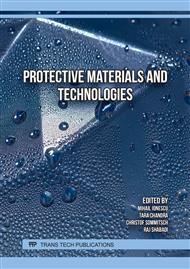p.63
p.69
p.75
p.81
p.87
p.95
p.103
p.109
p.117
Using Electropulsing to Control the Surface Quality of Casts
Abstract:
This paper reports on the mechanisms and provides worked examples of using pulsed electric current to improve the surface properties of conductive materials during solidification. A rough surface is formed via the freezing of thermomechanical fluctuations and external disturbances during solidification. Pulsed electric current provides an extra driving force for the fluctuations to relax in a shorter duration toward the equilibrium state before the material loses the fluidity during cooling. This additional mechanism is associated with the electric current free energy, which depends on the current density distribution at various materials geometries, including the surface profile. The mechanism has been validated by experimental characterization of the surface roughness evolution with and without electropulsing treatment.
Info:
Periodical:
Pages:
87-91
Citation:
Online since:
December 2023
Authors:
Keywords:
Price:
Сopyright:
© 2023 Trans Tech Publications Ltd. All Rights Reserved
Share:
Citation:



